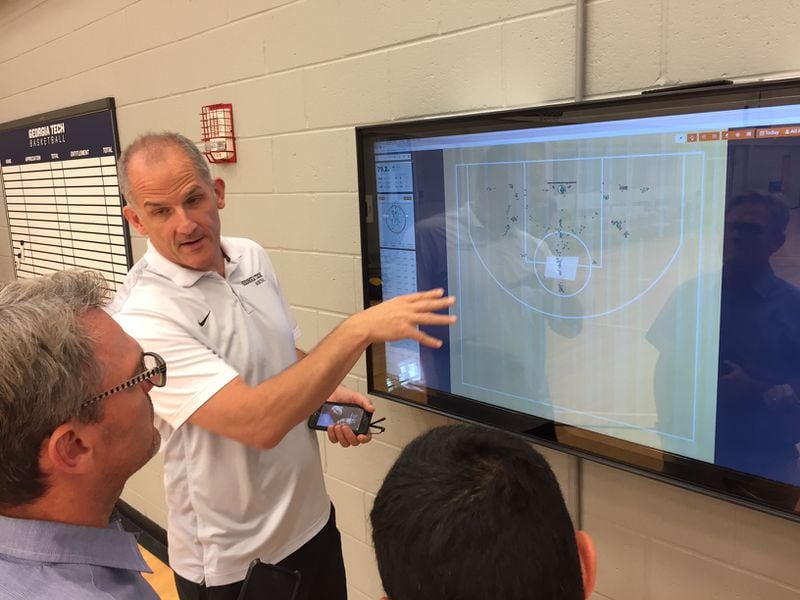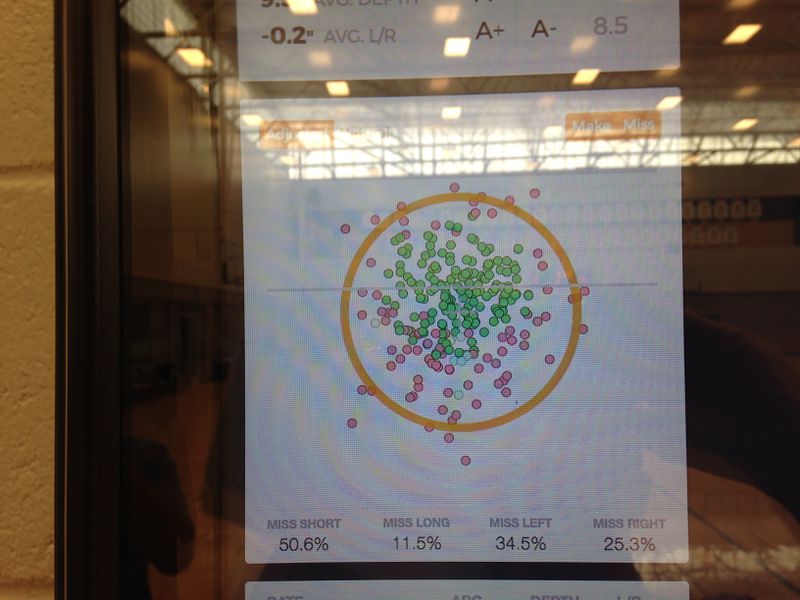A couple of steps behind the free-throw line, Josh Okogie tossed up soft jumpers in the sunlit gym at Georgia Tech’s Zelnak Basketball Center. A computerized voice provided immediate feedback on the angle of his shots as they descended on the basket.
“Forty-three. Forty-four. Forty-six,” spoke the voice as Okogie fed a series of shots through the rim.
For the Yellow Jackets’ oft errant shooting, a technological aid arrived last month, a $5,000 shot-tracking system that measures shot angle, left/right deviation, depth, position on the court and whether the shot scored. Using a sensor suspended 13 feet above the basket, the system logs data for individual players and can provide information served in charts, diagrams and heat maps, accessible on a wall-mounted television in the gym or remotely from a laptop or smartphone.
“I learned that my left and right’s pretty good,” Okogie said. “I always used to think that I would always shoot left, but, looking at the thing, I’m pretty good at shooting at the middle of the rim.”
Tech is one of about 30 Division I teams to have purchased the product from Noah Basketball, which was released about a year ago, company CEO John Carter said. The Jackets’ women’s team is also using the Noah system. Not even a couple of weeks after installation, the value was already clear for coach Josh Pastner’s team, which last season ranked 266th in Division I in 3-point shooting percentage (33.1 percent) and 247th in free-throw percentage (68.2 percent).
For instance, the data showed that, of forward Sylvester Ogbonda’s misses on a particular set of shots, 62 percent were short, and he missed to the left twice as often as he missed to the right. Ogbonda can be mindful of that as he shoots, and coaches can work on his form to get his shots centered up.
Assistant coach Eric Reveno, a technology-minded type who urged the purchase of the system, said he hoped it could help guard Justin Moore, whom Reveno is hard on himself for misses. Having Moore focus more on making his shot arc more consistent rather than on the end result could make him a better shooter.
“So it’s basically helping him focus on being more process oriented vs. result oriented,” Reveno said. “The game has enough result orientation to it.”
Noah’s data of more than 21 million shots that have been tracked and uploaded into its cloud indicates that a shot that approaches the basket at a 45-degree angle is optimal. If Moore – or any player – can commit the feel of a 45-degree angle shot to muscle memory, his time shooting alone in the gym figures to be much better spent than simply tossing up hundreds of shots.
“It’s not just make or miss where you just kind of zone out and shoot,” Reveno said. “It gets them to concentrate. Then there’s the technological component where some of the guys get into it and dork out a little bit.”
If you’re wondering, Noah’s data also indicates that shots that go through the basket at a depth of 11 inches from the front of the rim (the basket’s diameter is 18 inches) have the best chance of going in. A scatter-plot diagram of shots positioned on a map of the rim seems to confirm this. As Reveno showed the system to visitors to the practice gym recently, the preponderance of green dots, indicating makes, clustered heaviest about two-thirds of the way to the back of the rim.
“The swish isn’t the perfect shot,” Reveno said.
Reveno envisions potential uses for the Noah system when shots are tracked in McCamish Pavilion during games this season. Do players’ shot angles flatten later in games? Do they miss differently in games than they do in practice? Players also wear heart monitors during games and practice, which offers the possibility of pairing the two sets of data.
The system has perhaps an unintended benefit. Because data from each shooting session is recorded and available to any member of the team or staff, coaches can know which players are shooting how many shots on their own, and how many they’re making. (Players log in for an individual shooting session. In a scrimmage or game situation, shots are tracked manually on a tablet.)
“I like it a lot,” Okogie said. “It forces you to be accountable in the gym.”
Reveno was familiar with Noah, having used an earlier product as coach at Portland before his hire at Tech in 2016. A Stanford grad who grew up in Silicon Valley, he has long sought to find uses for technology in basketball and has embraced his employer’s spirit of technological innovation. He has had conversations, for instance, with faculty at Tech’s Wearable Computing Center about a sleeve that could track the movement of a player’s shooting arm to determine if he is cocking and releasing the ball on a straight trajectory to the basket.
“I like to kick this stuff around, but there’s people on campus who are doing amazing stuff,” Reveno said.
Going into his second season, Pastner might not need shooting that is amazing. But if a shot sensor can help the Jackets win games, he might be tempted to call it a modern miracle.








